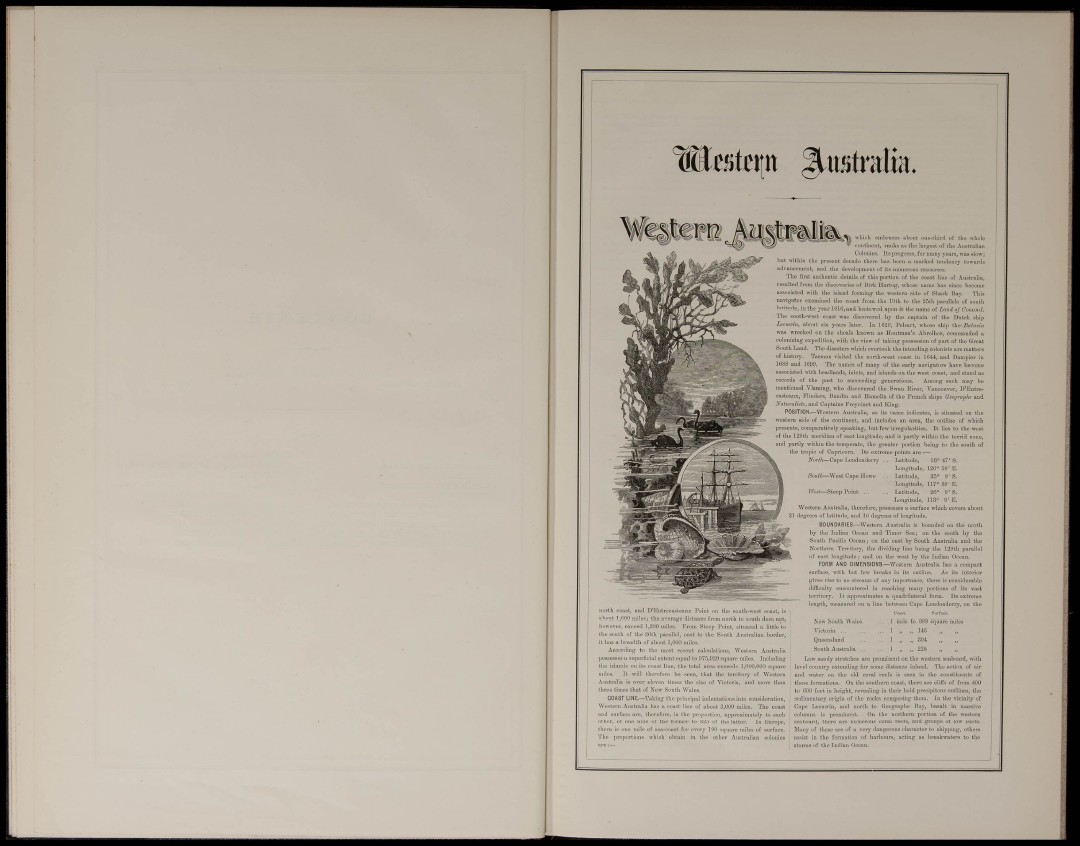
Âiîtqjt ^mtvïïlm.
iiortli coast, aud D'Eutrecnsteaux Point on the soutli-west coast, is
about 1,600 milesj the nyerage distauoe from nortli to south does not,
liowever, exceed 1,200 miles. From Steep Point, situated a littlo to
tlie soulli of the 26th parallel, oast to the South Aiistraliau border,
il has a breadth of about 1,000 miles.
Acoordiug to the most reoeut calculations, "Western Australia
possesses a superlicial exteut equal to 975,920 square miles, Including
the islands on its coast line, the total area exceeds 1,000,000 square
wiles. It mil therefore bo seen, that the territory of Western
Australia is over eleven times the size of Victoria, and more than
three times that of Now South AVules.
COASTLINE.—Taking the principal indentations into consideration,
\Vesteru Australia has a coaat line of about 3,000 miles. The coast
and surface ai-e, therefore, in the proportion, approximately to each
nthor, of one mile of the foi-mei- to 325 of the latter. In Europe,
tlici-e is one miio of sea-coast for every 190 squai-e miles of surface.
IMie proportions which obtain in the other Anstrnlian colonies
which embraces about one-third of the whole
continent, ranks as the largest of the Austi'alian
Colonies. Its progress, for many years, was slow;
but wtMn the present decade there haa been a marked tendency towards
aavancement, and the development of its numereus resources.
The first authentic details of this portion of the coast line of Australia,
resulted from the discoveries of Dirk Hartog, whose name has since become
iiated with the island forming the weatern side of Shark Bay. This
fator examined the coast from the lOth to the 2ôth parallels of south
lauiude, in the year 1(316, and bestowed upon it the name of Land of Concord.
The south-west coast was discovered by the captain of the Dutch ship
Lteumn, about sis years later. In 1629, Pelsart, whose ship the-Siiiain'oe
was wrecked on the shoals known as Houtman's Abrolhos, commanded a
colonizing expedition, with the view of taking possession of part of the Groat
South Land. The disasters which overtook the intending colonists are matters
of history, Tasman visited the north-west coast in ICi-t, and Dainpier in
1688 and 1(399. The names of many of the early navigators have become
associated with headlands, inlets, and islands on the west coast, and stand as
records of the past to succeeding generations. Ainoiig such may be
mentioned Vlaming, who discovered the Swan River, Vancouver, D'Entrecasteaus,
Flinders, Baudin and Hamelin of the French ships Geog raphe and
Naluralùte, and Captains Freycinet and King.
POSITION,-Western Australia, as its name indicates, is situated on the
western side of the continent, and includes an area, the outline of which
presents, comparatively speaking, but few ¡regularities. It lies to the west
of the 129th meridian of east longitude, and is partly within the torrid zone,
and partly within the temperate, the gi-eater portion being to the south of
the tropic of Capricorn. Its extreme points are :—
iÎoriA—Cape Londonderry .,, Latitude, 18«47'S.
Longitude, 126° 58' E.
Latitude, 33° 8'S.
Longitude, 117» 89'E.
Latitude, 26" 9'S.
Longitude, 113° 9'E.
So«î;i—West Cape Howe
Tl'I'sf—Steep Point ...
Western Australia, therefore, possesses a surface which covers about
21 degrees of latitude, and 16 degrees of longitude.
BOUNDARIES,—Western Australia is bounded on the north
by the Indian Ocean and Timor Sea; on the south by the
South Pacific Ocean; on the oast by South Australia and the
Northern Territory, the dividing line being the 129th parallel
of east longitude ; and on the west by the Indian Ocean.
FORM AND DIMENSIONS—Western Australia has a compact
surface, with but few breaks in its outliue. As its interior
gives rise to no streams of any importance, there is considerable
difficulty encountered in reaching many portions of its vast
territory. It approximates a quadrilatenil form. Its extreme
length, measured on a line between Cape Londonderry, on the
ComU Surfocfl.
New South AVales .... 1 mile to 388 square miles
Victoria 1 „ „ 146 „ „
Queensland 1 „ „ 804 „ „
South Australia 1 „ „ 226 „ „
Low sandy stretches are prominent on the western seaboard, with
level country extending for some distance inland. The action of air
and water on the old coral reefs is seen in the constituents of
these formations. On the southern coast, there are cliffs of from 400
to 600 feet in height, reveahng in their bold precipitous outlines, the
sedimentary origin of the rocks composing them. In the vicinity of
Cape Leeuwin, and north to Geographe Bay, basalt in massive
columns is prominent. On the northern portion of the western
seaboard, there are numerous coral reefs, and groups of low islets.
Many of these are of a very dangerous character to shipping, others
assist in the formation of harboni-s, acting as breakwaters to the
storms of the Indian Ocean.